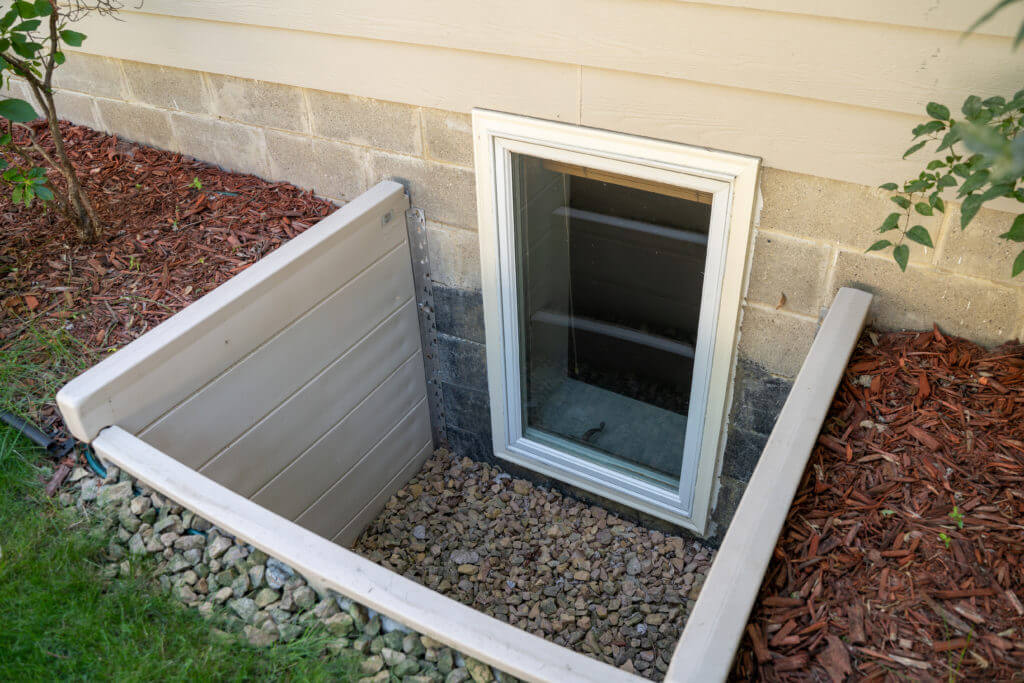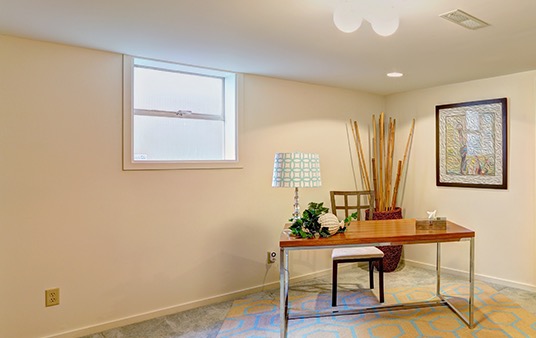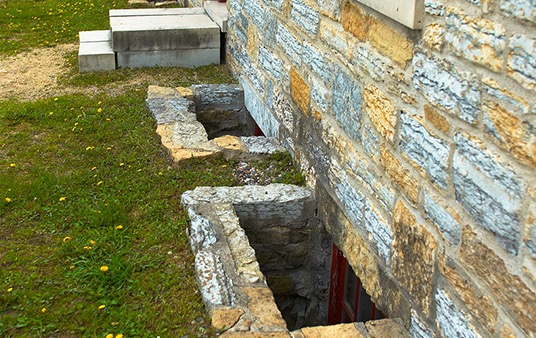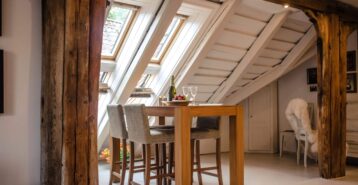What Is an Egress Window?
An egress window is a window specifically designed to provide a safe and accessible exit from a home during an emergency, such as a fire or medical situation. These windows are easy to open, large enough to climb through, and also allow emergency personnel to enter the home if needed. In simple terms, an egress window is one you can easily get in and out of. To qualify as an official means of egress, the window must meet specific size and clearance requirements set by building codes. Homeowners also have several window styles to choose from that comply with these standards.
If you’re planning an egress window installation, here’s what you need to know before you start.

Egress Window Requirements
Egress windows are required in bedrooms as well as in basements and attics that have been converted to extra living space/an additional bedroom.
Windows must be at least 24 inches high, 20 inches wide, and provide 5.7 square feet of a clear opening. If your window is in the basement or on the ground floor, it only needs 5 square feet of a clear opening. The window can still be a maximum of 44 inches from the floor.
Here’s what all that looks like when you break it down by room.
| Room | Window Height | Window Width | Minimum Square Footage of Window Opening |
|---|---|---|---|
| Basement bedrooms and living areas | 24 | 20 | 5 square feet |
| Ground floor bedrooms | 24 | 20 | 5 square feet |
| Higher floor bedrooms | 24 | 20 | 5.7 square feet |
| Attic converted to living space | 24 | 20 | 5.7 square feet |
What Does an Egress Window Cost?
The average cost for an egress window installation is $3,000. However, that average is tilted toward the high end by how often egress windows are installed in basements.
Explore all you need to know about your egress window cost before you meet with a contractor so nothing comes as a surprise.
Egress Window Types
Several window types work for an egress window installation, including:
- Casement Windows: These are hinged on one side.
- Double-Hung Windows: This window type includes two moveable sashes.
- Sliding Windows: Instead of opening up, down, or out, these slide open sideways.
- Awning Windows: Awning is a type of casement window that is hinged at the top and opens at the bottom.
- Hopper Windows: Another type of casement window, hopper windows are hinged at the bottom and swing inward from the top.
- Skylight Windows: An excellent option for single-story home bedrooms, though you will have to ensure it is an operable type as opposed to fixed.
Read more about egress window types here.
Egress Window Size Chart
Though there are some basic measurements to keep in mind in terms of height and width for an egress window, those measurements need to add up to a minimum clear opening of 5.7 square feet. Below, we have an egress window size chart showing how big the opening must be for some of the most popular window types to meet egress. Keep these egress window dimensions in mind as you are shopping for options!
| Window Type | Height | Width |
|---|---|---|
| Casement | 42 inches | 20 inches |
| Single- or Double-Hung | 28 inches | 30 inches |
| Sliding | 26 inches | 20 inches |
| Awning | 24 inches | 35 inches |
| Hopper | 24 inches | 35 inches |
Our guide to egress window size digs into these numbers in more depth.
Do I Need an Egress Window?
Determining whether you need an egress window depends on several factors, including local building codes, the specific use of the room (if it’s a bedroom or living space, for example), and the safety requirements for emergency exits in your area. Here are some guidelines to help you assess if an egress window is required in your home and if your current windows already meet egress.

1. Bedrooms
Egress windows are typically required in rooms used for sleeping, such as bedrooms. That includes basement bedrooms. The purpose is to provide a safe exit in case of an emergency, such as a fire or other hazards.
2. Basement Living Spaces
If you have a finished basement or plan to convert your basement into living space, you will likely need to install egress windows to comply with building codes and provide a safe exit for occupants. This may mean you need to excavate a window well or make an existing window well larger.
3. Window Size and Accessibility
Egress windows must meet specific size requirements to provide a clear opening for safe escape. The minimum clear opening width is typically 20 inches, and the minimum clear opening height is usually 24 inches. For basements, the window size increases to 36 inches by 36 inches. If you have a window that already fits those requirements, then you have an egress window! If you don’t, you may need to install one.
4. Window Height From Floor
Egress windows should be located at a certain height above the finished floor to ensure easy exit access for all occupants, including children and individuals with limited mobility. In the United States, the bottom of the window is usually not allowed to be more than 44 inches above the finished floor.

5. Home Safety
Even if it is not legally required, installing egress windows can significantly enhance the safety of your home and provide peace of mind for you and your family. If you live in an area prone to wildfires or other types of natural disasters, you may want to consider egress windows in all living areas in addition to the basement and bedrooms.
6. Future Home Sale
If you plan to sell your home in the future, having egress windows where required will be essential for meeting building code requirements and can be appealing to potential buyers. A basement egress window also typically allows more light into the room, which can increase your ROI.
Check the building codes and regulations in your local area. Building codes may differ from one jurisdiction to another, and they often specify the size, location, and accessibility requirements for egress windows in certain rooms.
Replacing Egress Windows in Old Homes
Even though egress windows are currently required by fire code in the United States, this wasn’t always the case. That means some older homes may have basements or bedrooms with windows that do not meet current egress standards.
Even once egress windows were required, those requirements were less stringent. For instance, egress window regulations for a second story used to require 5 square feet of space when opened, and today they require 5.7 square feet. That’s because the fire codes now take into account a rescue ladder as well as a fireman in full protective gear.

To verify that your windows are large enough, it is important to walk around your home and measure each of them to see if they are at least 24 inches tall and 20 inches wide and that they have a full opening of at least 5 square feet on the ground floor and 5.7 square feet on higher stories of the house.
Only certain window brands offer egress windows, so you will want to talk to your local window installer about which window brand is the best for this type of window installation.
Egress Windows FAQs
What Are the Rules for Egress Windows?
Egress windows must meet local building codes, which typically follow the International Residential Code (IRC). These windows are required in every bedroom, basement bedroom, and any finished basement living space. The goal is to provide a safe exit during emergencies and a clear entry point for rescue personnel. In most cases, the window must meet minimum size requirements and be easy to open without tools or keys.
What Are the Minimum Requirements for Egress Windows?
To meet egress requirements, a window must:
- Open at least 20 inches wide and 24 inches high
- Offer a minimum 5.7 square feet of clear opening (or 5.0 square feet on ground-level floors)
- Have a sill height of no more than 44 inches from the finished floor
- Open fully without needing special tools or force
If the window is in a basement and sits below grade, it also needs a window well that meets certain depth and clearance requirements.
Does a 36 by 36 Window Meet Egress?
Yes, a 36 by 36 inch window generally meets egress size requirements. This size equals 9 square feet, which exceeds the minimum 5.7 square feet of clear opening required for upper floors. However, meeting the size standard is just one part. The window must also fully open and sit no more than 44 inches from the floor. If it’s installed in a basement, a properly sized window well is also necessary.
Is It Illegal to Have a Bedroom in the Basement Without an Egress Window?
Yes, in most areas, a basement bedroom without an egress window violates building codes. These codes exist to protect occupants in case of fire or other emergencies. Without a window that allows a quick exit or emergency access, the space is considered unsafe for sleeping. If you plan to add a bedroom to your basement, installing a code-compliant egress window is essential and often required for permits and inspections.
Egress Window: The Bottom Line
Every home in the U.S. requires at least one egress window. Every bedroom in your home needs one, plus any attic space or basement space that has been converted into living area or additional bedrooms.





